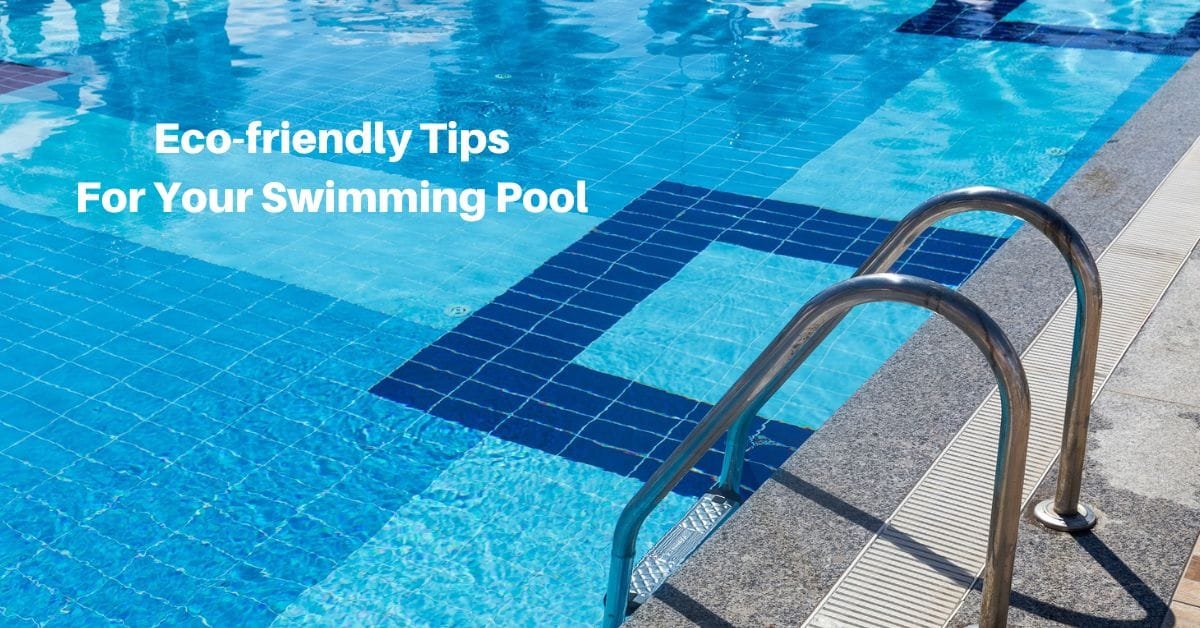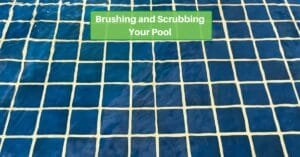A pool is a refreshing escape during warmer months. Still, it also comes with environmental costs that are easy to overlook. Pools use significant amounts of water and energy; they may also introduce chemicals into the environment that can impact soil and nearby water sources. Eco-friendly practices can help you enjoy your pool responsibly, minimizing its environmental footprint. And many of them can also help you save money!
How Pools Affect The Environment
Let’s start by looking at some of the issues to be mindful of with your home swimming pool.
Water Consumption
One of the primary environmental impacts of traditional pools is their water consumption. Pools require lots of water to fill initially, but the demand continues. Evaporation, splashing, and maintenance routines often require you to top off the water level throughout the swimming season.
Each refill draws on local water resources, which can strain supplies, especially during droughts or in areas that experience water scarcity. In regions facing increased water restrictions, adopting water conservation practices is an environmentally responsible choice and a necessity.
Energy Usage
Beyond water consumption, the energy required to maintain a pool can be considerable. Pool pumps, heaters, and lighting can increase energy bills and contribute to greenhouse gas emissions, depending on the energy source.
Pumps typically run for hours every day to filter the water. Heaters are often needed to maintain a comfortable swimming temperature. Lighting adds another layer of energy use, mainly if outdated incandescent bulbs are used.
Even though pools may be a backyard luxury, you can still reduce energy usage by adopting efficient equipment and adjusting energy consumption habits.
Chemical Runoff and Its Effects
Maintaining clean water often involves chemical treatments, such as chlorine, that prevent algae growth and harmful bacteria. These chemicals are effective but can harm the surrounding environment if they enter the soil or runoff reaches nearby water sources.
When a pool is backwashed or drained, these chemicals can seep into groundwater, potentially affecting local ecosystems. Strong pool chemicals may also affect air quality around the pool area, posing health risks for you, your family, and friends, as well as nearby plants and animals.
For pool owners, embracing eco-friendly practices doesn’t mean sacrificing the enjoyment of their pools. It’s about understanding how pools impact the environment and taking small but meaningful steps to reduce that impact.
From conserving water and energy to exploring chemical-free treatment options, there are many ways to make pools more sustainable while creating a healthy outdoor space for you and nature.
Water Conservation Strategies
Water conservation is a central aspect of eco-friendly pool ownership, especially for those who live in areas prone to drought or water restrictions. Reducing water waste conserves precious resources and lowers maintenance costs. It can even extend the life of pool equipment.
Here are several effective strategies for minimizing water use in pools:
Invest in a Pool Cover
A pool cover is one of the most effective tools for conserving water. Covering the pool when it’s not in use can significantly reduce evaporation, a significant source of water loss. Covers can reduce evaporation by up to 90%, saving hundreds or even thousands of gallons of water each season.
A pool cover also helps keep debris out, reducing the frequency of cleaning and chemical rebalancing, which often requires adding more water to the pool. Automatic and solar covers are available to make the process even easier and more energy-efficient.
Maintain Optimal Water Levels
Overfilling the pool can lead to unnecessary water loss from splashing. In contrast, an underfilled pool may expose pool walls and equipment to damage. Maintaining water at the correct level is essential for water conservation and the longevity of your pool structure and equipment.
During the height of summer, keep an eye on water levels and refill only as needed to maintain the recommended level. Installing a water level monitor can help track fluctuations and alert you when the water needs topping up.
Use Landscaping to Reduce Splash-Out
A natural windbreak around your pool can help reduce water loss from wind-driven evaporation. Strategic landscaping with shrubs, trees, or privacy screens can shield your pool from strong breezes that accelerate evaporation.
Designing your pool area to direct splash-out water back into the pool rather than onto surrounding surfaces can reduce the need to top off water levels. Paving with materials that slope toward the pool or installing splash-resistant edging around the pool can help retain more water.
Opt for a Variable-Speed Pool Pump
Pumps are essential for filtering pool water, but they can consume considerable energy if left running at high speeds. A variable-speed pump adjusts to different speeds as needed, optimizing filtration without excessive energy use. Running the pump at lower speeds reduces strain on the equipment and minimizes water evaporation caused by high-speed circulation. While they may cost more upfront, variable-speed pumps are eco-friendly and lower water and energy usage over time.
By implementing these water conservation methods, pool owners can significantly impact their overall water usage. Conserving water benefits the environment and reduces the frequency of refills, saving money and making pool ownership more sustainable. The minor adjustments above can lead to significant changes over time, demonstrating that even a tiny effort toward conservation can go a long way.
Chemical Management and Filtration
Effective chemical management and filtration practices are essential for maintaining clean, safe pool water while minimizing environmental impact. By reducing the use of chemicals and optimizing filtration systems, you can create a healthier pool environment and lessen the ecological footprint of your pool.
Minimize Chemical Use with Proper Testing
Overuse of chemicals, particularly chlorine, can harm local waterways if pool water needs to be drained or splashes out frequently.
Regularly test your pool’s pH, alkalinity, and chlorine levels to maintain the proper balance. Pool test kits make it easy to monitor and adjust chemicals only when necessary, avoiding overuse and keeping your pool as close to neutral as possible. By staying on top of these levels, you’ll be able to reduce your reliance on chemicals and improve water quality naturally.
Embrace Saltwater or Mineral Pool Systems
Switching to a saltwater or mineral-based pool system can reduce the need for traditional chlorine. Saltwater pools use a salt chlorine generator that converts salt into chlorine at lower levels than conventional chlorination.
Mineral systems, on the other hand, use a combination of silver and copper ions to keep water clean without as many chemicals. Both options are gentler on the skin, eyes, and environment, making them an excellent choice for those looking to create a more natural, eco-conscious pool.
Opt for Natural Pool Treatments
Various eco-friendly treatments are available that replace or reduce the need for chemicals. Enzyme-based treatments are an excellent option for breaking down organic contaminants, while phosphate removers prevent algae growth.
These products are biodegradable and pose less harm to aquatic life if water is accidentally released. Using such treatments in combination with regular testing and balanced water levels creates a low-maintenance, sustainable pool environment.
Upgrade to a High-Efficiency Filtration System
An energy-efficient filtration system can reduce both water and energy consumption. Cartridge filters are a particularly eco-friendly choice because they don’t require backwashing, which is common with traditional sand filters. Backwashing wastes water and reintroduces chemicals into the environment.
By upgrading to cartridge filters, you can improve water quality, reduce chemical dependency, and avoid the need for frequent refilling. Also consider a high-efficiency pump with a timer, so your filtration system operates at optimal intervals, reducing energy waste.
Implementing these chemical and filtration strategies helps reduce your pool’s environmental impact and promotes a healthier, more sustainable water environment. With a bit of care in your maintenance routine, you can enjoy clean, clear water without excessive chemical use or energy costs.
Pool Covers, Landscaping, and Water Conservation
A significant part of eco-friendly pool ownership involves simple but impactful practices such as using pool covers, thoughtfully planning landscaping around the pool, and taking steps to conserve water. These measures not only help protect the environment but can also save on energy and maintenance costs.
Invest in an Eco-Friendly Pool Cover
Using a pool cover is one of the most effective ways to conserve water and naturally maintain your pool’s temperature. Pool covers reduce evaporation, which can save thousands of gallons of water each season. They also retain heat, so you can save on heating costs if you want to use your pool during cooler months.
Solar pool covers are an environmentally friendly choice, designed to absorb sunlight and transfer heat to the water. This means you’ll have less of a need for electric or gas heating systems.
A cover also keeps debris out of the pool, helping reduce the need for chemical treatments and frequent cleaning. When choosing a cover, consider durability and efficiency. Opt for materials that are both long-lasting and effective at heat retention and debris control.
Landscape with Purpose
Thoughtful landscaping around the pool can provide shade, privacy, and temperature regulation. Planting native trees, shrubs, or hedges enhances the pool’s aesthetic appeal while reducing water evaporation by providing shade during hot weather.
Native plants are particularly beneficial, requiring less water, resisting local pests, and supporting local ecosystems, like bees, birds, and butterflies.
Creating a buffer zone with mulch or drought-resistant ground covers around the pool helps prevent soil erosion, reduces water runoff, and keeps dirt and debris from blowing into the pool. Avoid plants with invasive root systems near the pool area – they could damage pipes and walls over time.
Reduce Water Waste
Minimizing water waste is essential for eco-conscious pool ownership. Simple adjustments like maintaining the pool’s water level can significantly impact water conservation. Overflowing or splashing leads to water loss, which can be controlled by keeping water levels within the pool’s recommended limits. If you have a spa feature, avoid overfilling it to help prevent unnecessary water use.
A rainwater catchment system is also a good idea. Rainwater can be collected and directed to the pool, which can help replenish water levels without drawing from local water supplies. Installing a rain barrel is a simple way to start this process and utilize natural water sources effectively.
Repair Leaks Promptly
Even minor pool leaks can lead to significant water loss over time. Conduct regular inspections of your pool structure, plumbing, and equipment to spot any leaks early. Watch for signs such as damp areas around the pool, fluctuations in water levels, or sudden increases in your water bill. Addressing leaks promptly conserves water, reduces chemical costs, and prevents further structural damage, which can be costly.
By incorporating eco-friendly practices like these, you can enjoy a refreshing and inviting pool while significantly reducing its environmental impact. Implementing these measures can make a lasting difference, creating a sustainable pool area that enhances your outdoor living space while respecting the environment.









